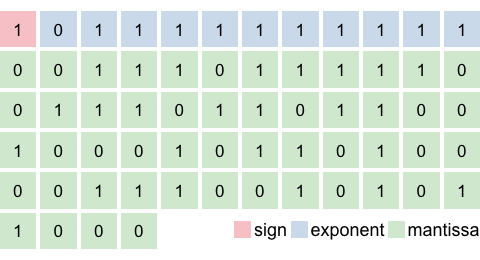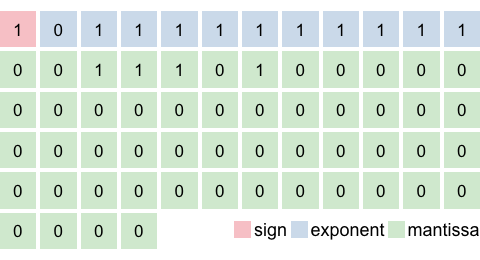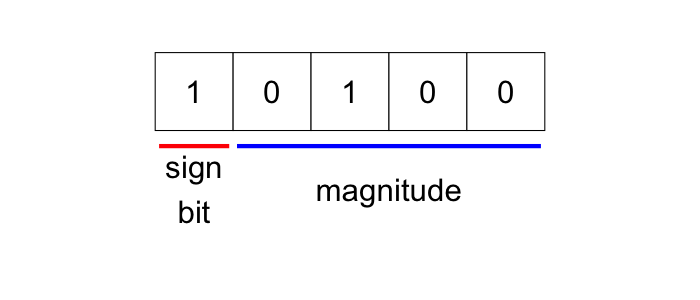The goal of lofi is to squeeze multiple, low-fidelity representations of colours and numbers into the 32-bits of a single, standard integer in
R.
This low-fidelity representation of values (a.k.a. lofi) is usually only an approximation of the original values, and reconstructed values will most likely be slightly different from the original.
Visit the webpage for more in-depth documentation.
What’s in the box
-
pack()andunpack()are the key functions for packing/unpacking multiple values into the bits of an integer - There is a suite of low-level functions for handling each particular supported type e.g.
dbl_to_lofi()andlofi_to_dbl()
Installation
You can install from GitHub with:
pack() and unpack()
The pack() function will encode a set of values into the bits of a single integer. The unpack() function will reconstruct the original values from this single integer.
The schematic below illustrates the method by which a list of values is packed into a single integer and then unpacked back into the list of values. pack() and unpack() in turn rely on some lower level functions X_to_lofi() and lofi_to_X() (as indicated in the yellow boxes).

The key to the process is the packing specification (a.k.a. pack_spec) which defines the type of value you want to store how many bits are used to store each value.
Steps for using this package:
- Define a
pack_specdefining how each value is converted to lofi - Call
pack()on a named list of values, along with thepack_spec - Receive back a single integer containing all the packed lofi bits
- Call
unpack()on the single integer (along with thepack_spec) - Receive a list of reconstructed values which are the same as the original values - but maybe with some loss of precision.
The pack_spec defines information on packing the following types:
| type | lossless? | nbits | description | signed |
|---|---|---|---|---|
| integer | Yes | 1-32 | pack standard integer | optional |
| logical | Yes | 1-32 | standard 1-bit logical. zero-padded if needed | NA |
| choice | Yes | 1-32 | almost like a factor representation | NA |
| double | No | 1-32 | pack a standard double | optional |
| colour | No | 3-24 | pack a hex colour e.g. #123456 | NA |
| scaled | No | 1-32 | pack a range into the given bits | NA |
| custom | Possibly | 1-32 | user specified functions used to pack/unpack | NA |
The integer, logical and choice types are lossless, and original values can be perfectly reconstructed by unpack(). The double, colour and scaled types all quantize the inputs in some way and lose information - thus the original value is always imperfectly reconstructed (except in very particular circumstances).
For information on the specification for each type, see ?lofi::pack or vignette("packing-specification", package='lofi'
Example - pack/unpack the first row of iris data
The iris dataset gives the measurements in cm of the variables sepal length and width, and petal length and width, respectively, for 50 flowers from each of 3 species of iris. The first rows of the data are shown below:
| Sepal.Length | Sepal.Width | Petal.Length | Petal.Width | Species |
|---|---|---|---|---|
| 5.1 | 3.5 | 1.4 | 0.2 | setosa |
| 4.9 | 3.0 | 1.4 | 0.2 | setosa |
| 4.7 | 3.2 | 1.3 | 0.2 | setosa |
First rows of iris data
The pack_spec for the data seen in iris is:
-
Sepal.Lengthis a floating point value with 1 decimal place with a maximum value of 7.9. This could be multiplied by 10, converted to an integer and stored in 7 bits. - Similarly for
Sepal.Width,Petal.LengthandPetal.Width- after multiplying by 10, and treating as an integer, these values could all by stored in 6, 7, and 5 bits respectively. -
Speciesis a choice from 3 options, so in the best case we only need 2 bits to store this information.
The defined pack_spec is stored as a list:
#~~~~~~~~~~~~~~~~~~~~~~~~~~~~~~~~~~~~~~~~~~~~~~~~~~~~~~~~~~~~~~~~~~~~~~~~~~~~~
# Can perfectly pack 'iris' into 27 bits per row.
#~~~~~~~~~~~~~~~~~~~~~~~~~~~~~~~~~~~~~~~~~~~~~~~~~~~~~~~~~~~~~~~~~~~~~~~~~~~~~
pack_spec <- list(
Sepal.Length = list(type = 'integer', nbits = 7, mult = 10, signed = FALSE),
Sepal.Width = list(type = 'integer', nbits = 6, mult = 10, signed = FALSE),
Petal.Length = list(type = 'integer', nbits = 7, mult = 10, signed = FALSE),
Petal.Width = list(type = 'integer', nbits = 5, mult = 10, signed = FALSE),
Species = list(type = 'choice' , nbits = 2,
options = c('setosa', 'versicolor', 'virginica'))
)Now take the first row of iris and pack() it:
So the first row of iris has now been packed into the integer: 54052616.
If this integer is viewed as the 32 bits which make it up, the different lofi data representations can be identified:

If the integer is now unpack()ed, we get back the original data.
lofi::unpack(54052616L, pack_spec)
#> $Sepal.Length
#> [1] 5.1
#>
#> $Sepal.Width
#> [1] 3.5
#>
#> $Petal.Length
#> [1] 1.4
#>
#> $Petal.Width
#> [1] 0.2
#>
#> $Species
#> [1] "setosa"For an example of using lofi to pack an entire data.frame see vignette("packing-a-data-frame", package='lofi')
Conversion to/from low-fidelity representation
Underneath pack() an unpack() is a suite of low-level functions for handling each particular supported type
-
dbl_to_lofi(),lofi_to_dbl() -
int32_to_lofi(),lofi_to_int32() -
hex_colour_to_lofi(),lofi_to_hex_colour() -
lgl_to_lofi(),lofi_to_lgl() -
choice_to_lofi(),lofi_to_choice()
64-bit (double precision) floating point to Lofi
Double precision floating point values are converted to low-fidelity representation by truncating the mantissa, and re-encoding the exponent. Low-fidelity floats have limited range, poorer precision, and will almost never give back the exact starting value when unpack()ed.
Note: lofi has no explicit support for NA, NaN, Inf or denormalized numbers.
The following converts a double into a 10 bit float (with a sign bit, 2-bit exponent and 7-bit mantissa). The reconstructed double is close to the original value, but not an exact match.
| Representation | Bits | Value | Bit layout |
|---|---|---|---|
| Double precision | 64 | -1.234 |  |
Lofi double dbl_to_lofi(-1.234, float_bits = c(1, 2, 7))
|
10 | 669L |  |
Reconstructed double lofi_to_dbl(669L, float_bits = c(1, 2, 7))
|
64 | -1.226562 |  |
For more example of using lofi to pack double precision floating point values see vignette("lofi-double", package='lofi')
RGB Hex Colour to Lofi
- Hex colours are converted to lofi representation by considering each of the three 8-bit colour channels and quantizing the value into fewer bits.
- The number of bits can be specified individually for the separate R, G and B colours.
- The folowing shows that the reconstructed colour isn’t identical to the original, but it is still a reasonable approximation.
| Representation | Bits | Value | Colour sample or bit layout |
|---|---|---|---|
| Original colour | 24 | #123456 |  |
Low-fidelity colour hex_colour_to_lofi('#123456', rgb_bits = c(3, 3, 2)))
|
8 | 5L |  |
Reconstructed colour lofi_to_hex_colour(5L, rgb_bits = c(3, 3, 2))
|
24 | #002455 |  |
For more example of using lofi to pack colours see vignette("lofi-colour", package='lofi')
Integer to Lofi
- Integers are converted to low-fidelity representation by truncacting any leading zeros (or, in the case of negative numbers, truncating the leading ones)
- Keeping a leading bit for the sign is optional, and if it is excluded then the lofi representation is only able to hold positive numbers
-
loficorrectly keeps the sign bit and twos-complement for negative values
| Representation | Bits | Value | bit layout |
|---|---|---|---|
| Original integer | 32 | -12 | |
Low-fidelity integer int32_to_lofi(-12L, nbits = 5, signed = TRUE)
|
5 | 20L |  |
Reconstructed integer lofi_to_int32(20, nbits = 5, signed = TRUE)
|
32 | -12 |
Caveats + Future
- The
pack/unpackspec is limited to 32-bits as- this is my use case.
- that’s the maximum number of bits in an R integer
-
doublevalues are 64-bits but they don’t have built-in support for bitwise logical operations likebitwAnd()etc.
- It should be possible to instead pack/unpack values into a unlimited stream of
rawbytes. This may be considered for future versions. - Factors can not be directly packed. You will have to convert to another representation (e.g. character) and encode with
choice_to_lofi().


